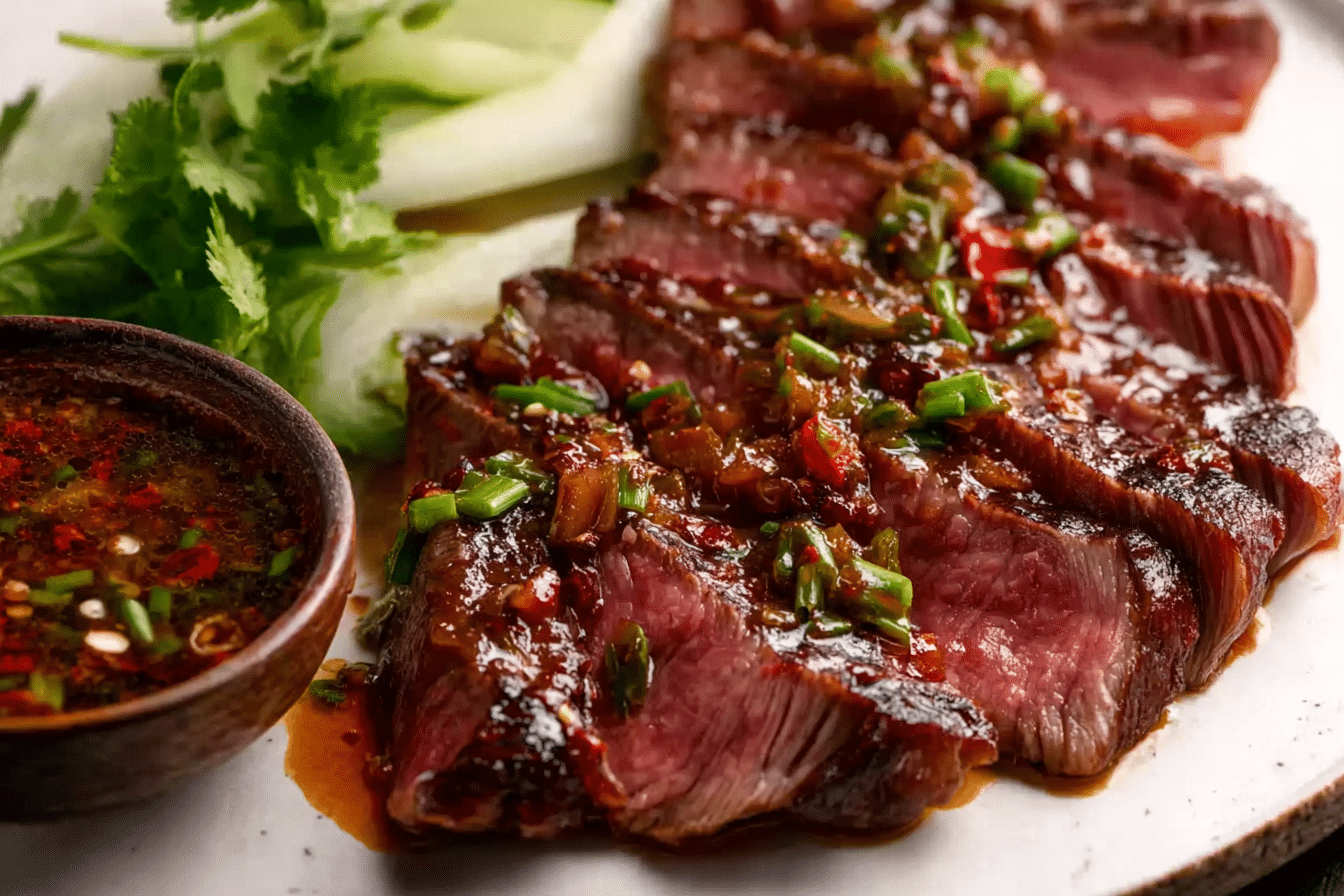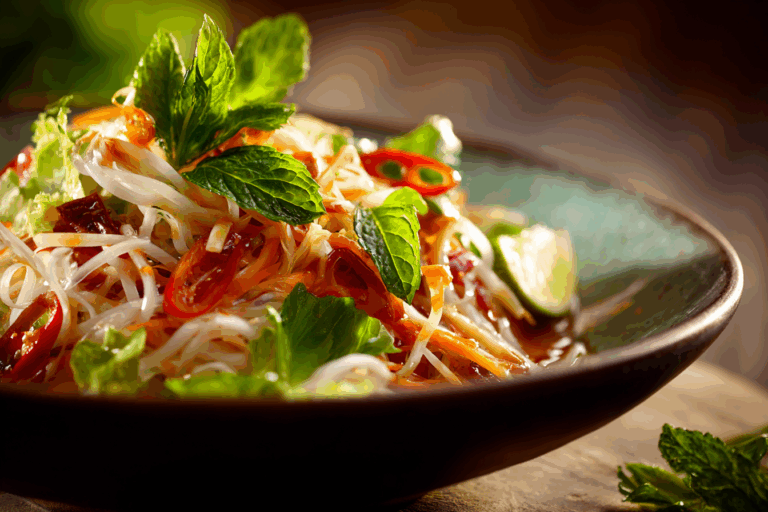How To Make Crying Tiger Beef
Crying Tiger Beef is one of those dishes that instantly grabs your attention not just for its unique name, but for its incredible flavor that lingers long after the last bite. Here at JustThaiRecipes, we have a special love for dishes that tell a story, and this one is no exception. From the first time I, Lina, tried it in a bustling Thai market, I knew it would become a recipe worth sharing with the world.
My journey into Thai cooking started long before this site was even born. Along with my partner, I built JustThaiRecipes to be more than just a recipe blog; it’s a love letter to Thai cuisine, a place where you can smell the lemongrass, taste the fiery chili, and feel the warmth of a home-cooked meal. We believe in preserving traditional flavors while also making them approachable for kitchens everywhere.
Crying Tiger Beef with its tender, char-grilled slices of beef, smoky aroma, and bold dipping sauce perfectly embodies that mission. In this article, you’ll discover the origins of the dish, the secrets behind its unforgettable taste, tips for perfect preparation, and variations you can try.
We’ll walk through every step, from choosing the right cut of beef to mastering the tangy, spicy dipping sauce. Along the way, we’ll sprinkle in ideas like crying tiger beef salad for lighter days, or a crying tiger chicken twist for poultry lovers. And if you’ve ever wondered why this dish has such a dramatic name, you’ll soon find out. So get ready to explore a recipe that’s not just food it’s a culinary adventure waiting to happen.
Learn more about authentic Thai flavors with our Thai Yellow Chicken Curry with Potatoes.
Table of Contents
Table of Contents
The Origins and History of Crying Tiger Beef
The Cultural Roots of Crying Tiger Beef in Thai Cuisine
Crying Tiger Beef, known in Thailand as “Suea Rong Hai,” translates directly to “Tiger Crying.” This name has sparked many stories and interpretations. Some say it refers to the beef being so delicious that even a tiger would weep if it couldn’t have more. Others suggest that the “crying” refers to the juices that drip from the meat as it’s grilled, reminiscent of tears.
This dish hails from Thailand’s Isan region in the northeast an area known for its bold, punchy flavors, heavy use of chili, and love for grilling meats over open flames. Isan food often blends Lao and Thai influences, producing dishes that are aromatic, spicy, and deeply satisfying. Crying Tiger Beef isn’t just a recipe; it’s part of a cultural identity that celebrates shared meals and intense flavors.
From Street Stalls to Fine Dining — How It Became Famous Worldwide
For decades, Crying Tiger Beef was a staple in Thai street food culture, served from small carts where the aroma of sizzling beef drew in crowds. The dish gained international attention through Thai restaurants abroad, often appearing as a menu highlight alongside classics like Pad Thai and Tom Yum soup.
Today, it’s celebrated not only in traditional Thai eateries but also in upscale restaurants, where chefs experiment with premium cuts like wagyu and incorporate fusion elements. Its fame is due to the perfect marriage of textures and flavors — tender beef, charred edges, and a dipping sauce that balances sour, salty, sweet, and spicy in every bite.
Choosing the Best Beef for Crying Tiger
The Importance of Selecting the Right Cut
When it comes to Crying Tiger Beef, your choice of beef is crucial to achieving that tender, juicy bite. In Thailand, cuts like brisket, rump, or flank are commonly used, but you’ll also find versions with premium cuts such as scotch fillet, porterhouse, or even wagyu for a melt-in-the-mouth experience. Each cut offers a different texture and flavor profile: brisket is rich and flavorful but requires careful cooking to avoid chewiness, while rump and porterhouse strike a balance between tenderness and bold beefy taste. If you prefer a luxurious twist, wagyu will elevate the dish with its marbled fat and buttery mouthfeel.
How Marbling and Thickness Affect Flavor
The marbling — those fine streaks of fat running through the meat — plays a big role in taste. As the beef grills, the fat melts, basting the meat from within and adding richness to every bite. Thickness matters too; slices that are too thin may dry out quickly, while overly thick cuts may be harder to cook evenly. Aim for about 2–3 cm thickness for the perfect sear and juicy interior.
Check out our guide on Thai Ginger Chicken: A Flavor-Packed Stir-Fry You’ll Love to explore how different protein cuts can transform flavor in Thai cooking.
Tips for Sourcing Quality Beef
Whenever possible, opt for grass-fed beef for a cleaner, more natural flavor. Farmers’ markets, specialty butchers, or online meat suppliers often have higher-quality options compared to standard supermarket fare. Look for beef with bright red coloring and a good amount of marbling this indicates freshness and flavor potential. If you’re making Crying Tiger Beef for a special occasion, investing in a higher-grade cut can make a noticeable difference.
Discover great ideas like How To Prepare The Most Delicious Thai Mango Sticky Rice for pairing a sweet Thai dessert with your savory beef dish.
Mastering the Crying Tiger Beef Marinade and Seasoning
The Signature Flavor Profile
The magic of Crying Tiger Beef lies in its marinade. Traditional recipes combine salty, savory, and slightly sweet elements to enhance the natural taste of the beef without overpowering it. Oyster sauce and seasoning sauce form the savory backbone, while a touch of oil helps lock in moisture during grilling. In Thailand, the marinade is kept simple because the real flavor punch comes from the dipping sauce — but getting the meat seasoned just right is still key.
For an authentic take, check out Marion’s Kitchen Crying Tiger Beef, where fresh herbs and perfectly balanced seasoning create a restaurant-quality result.
Marinating for Maximum Flavor
After piercing the beef with a fork to allow the marinade to penetrate, it’s important to rub the seasoning in for at least 5–10 minutes. This manual step ensures the flavors seep into the fibers of the meat. Then, let the beef rest in the marinade for 15–20 minutes (or up to several hours for deeper flavor). If you want a richer taste, refrigerate it overnight — just bring it back to room temperature before cooking.
Learn more about classic preparation methods in the Lion Brand Crying Tiger Recipe (Sua Rong Hai), which stays true to traditional Isan techniques.
Balancing Flavors Like a Thai Chef
Thai cooking thrives on balance — salty, sour, sweet, and spicy working together. In Crying Tiger Beef, the marinade focuses mainly on the salty-savory side, leaving the dipping sauce to provide tang and heat. However, some modern adaptations add a hint of palm sugar or honey to the marinade for a subtle caramelized crust.
For a delicious home-style guide, see Simply Suwanee’s Best Crying Tiger Recipe, which adds creative twists while respecting tradition.
Marinade Variations You Can Try
- Classic Isan Style: Oyster sauce, seasoning sauce, oil, no sugar.
- Sweeter Fusion Style: Add a teaspoon of palm sugar or honey.
- Herb-Infused Style: Incorporate lemongrass and garlic for fragrance.
- Smoky BBQ Style: Use smoked paprika for a Western-inspired twist.
For more adventurous flavor ideas, explore Thai Caliente’s Crying Tiger recipe, which also works beautifully with chicken.
And if you’re craving a salad spin, the Serious Eats Crying Tiger Thai Steak Salad combines grilled beef with fresh herbs and vegetables for a refreshing twist.
Perfecting the Grilling Technique for Crying Tiger Beef
Why Grilling Matters
In Crying Tiger Beef, grilling isn’t just about cooking the meat — it’s about infusing it with smoky depth and achieving that ideal balance between charred edges and juicy interiors. Traditionally, the dish is cooked over charcoal, which imparts a distinct aroma that’s hard to replicate with gas or electric grills. The open flame also helps caramelize the marinade, creating a slightly crispy crust that locks in flavor.
Charcoal vs. Pan Grilling
If you have access to a charcoal grill, it’s the gold standard for this recipe. The slow, even heat and natural smoke give the beef an authenticity that elevates the entire dish. However, a well-heated cast-iron pan or stovetop grill can also produce excellent results if you don’t have outdoor grilling space. Just be sure to preheat your pan until it’s almost smoking — this high temperature will give you a proper sear.
Timing and Temperature
The perfect Crying Tiger Beef should be cooked to medium-rare or medium to retain tenderness. For a 2–3 cm thick cut:
- Medium-rare: Grill each side for about 3–4 minutes.
- Medium: Grill each side for 4–5 minutes.
Resting the beef after cooking is essential — let it sit for 5–10 minutes before slicing. This allows the juices to redistribute, keeping each slice succulent.
Slicing for Maximum Enjoyment
Always slice the beef thinly against the grain. Cutting against the grain shortens the muscle fibers, making each bite more tender. Arrange the slices neatly and serve immediately with the dipping sauce to capture the full sensory experience of the dish.
Pro Tips for a Perfect Finish
- Avoid flipping the beef repeatedly — one flip is enough for an even sear.
- Keep the grill or pan dry; excess marinade should be patted off to prevent steaming instead of searing.
- Use tongs instead of a fork to avoid piercing the meat and losing juices.
- If using charcoal, add a few pieces of hardwood for extra aromatic smoke.
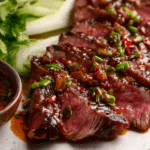
Crying Tiger Beef
- Prep Time: 30 mins
- Cook Time: 10 mins
- Total Time: 40 mins
- Yield: 2 servings 1x
- Category: Main Dish
- Method: Grilling
- Cuisine: Thai
- Diet: Halal
Description
A flavorful Thai-style marinated beef dish served with a tangy, spicy tamarind-based dipping sauce. The beef is tenderized with seasoning and oyster sauce, then grilled or pan-cooked to perfection.
Ingredients
- 300g beef (see note 1)
- 1/2 tbsp oyster sauce
- 1 tbsp seasoning sauce
- 1 tbsp cooking oil
Dipping Sauce:
- 2 tbsp tamarind sauce
- 2 tbsp fish sauce
- 1/2 tbsp palm sugar
- 1 tbsp chili flakes
- 1 tbsp grounded roasted rice
- 1/2 tbsp chopped shallot
- 1/2 tbsp chopped spring onion
- 1/2 tbsp chopped coriander
- 1/2 tbsp chopped sawtooth coriander (optional, see note 2)
Instructions
- Use a fork to pierce the beef all over, then add seasoning sauce and oyster sauce. Rub the mixture into the beef for 5–10 minutes.
- Add the cooking oil and rub well again.
- Let the beef marinate for 15–20 minutes.
- Cook using your preferred method: grilling on charcoal, BBQ, or pan grill until desired doneness.
- Rest the steak before slicing.
- For the dipping sauce: In a bowl, combine tamarind sauce, fish sauce, and palm sugar. Mix until the sugar dissolves.
- Add chili flakes, grounded roasted rice, and all herbs. Mix well and taste, adjusting seasoning if required.
- Serve the sliced beef with the dipping sauce.
Notes
- Note 1: Beef brisket was used in this recipe, but other options include rump steak, scotch fillet, porterhouse, or wagyu.
- Note 2: Sawtooth coriander (culantro) can be found in some Asian grocery stores and can also be used in dishes like Tom Yum.
Nutrition
- Serving Size: 1 serving
- Calories: 320
- Sugar: 5g
- Sodium: 980mg
- Fat: 20g
- Saturated Fat: 7g
- Unsaturated Fat: 11g
- Trans Fat: 0g
- Carbohydrates: 8g
- Fiber: 1g
- Protein: 28g
- Cholesterol: 75mg
Keywords: Thai beef recipe, grilled beef with tamarind sauce, Thai dipping sauce, marinated beef steak, Thai BBQ beef
The Iconic Crying Tiger Beef Dipping Sauce
The Flavor Balance
The dipping sauce, known in Thai as Nam Jim Jaew, is the soul of Crying Tiger Beef. It’s what transforms a beautifully grilled piece of meat into a burst of flavor with every bite. The magic lies in balancing four key taste elements — salty, sour, sweet, and spicy — in perfect harmony. Tamarind provides the tang, fish sauce adds savory depth, palm sugar rounds out the edges with subtle sweetness, and chili flakes bring the fiery kick that defines Thai cuisine.
Core Ingredients
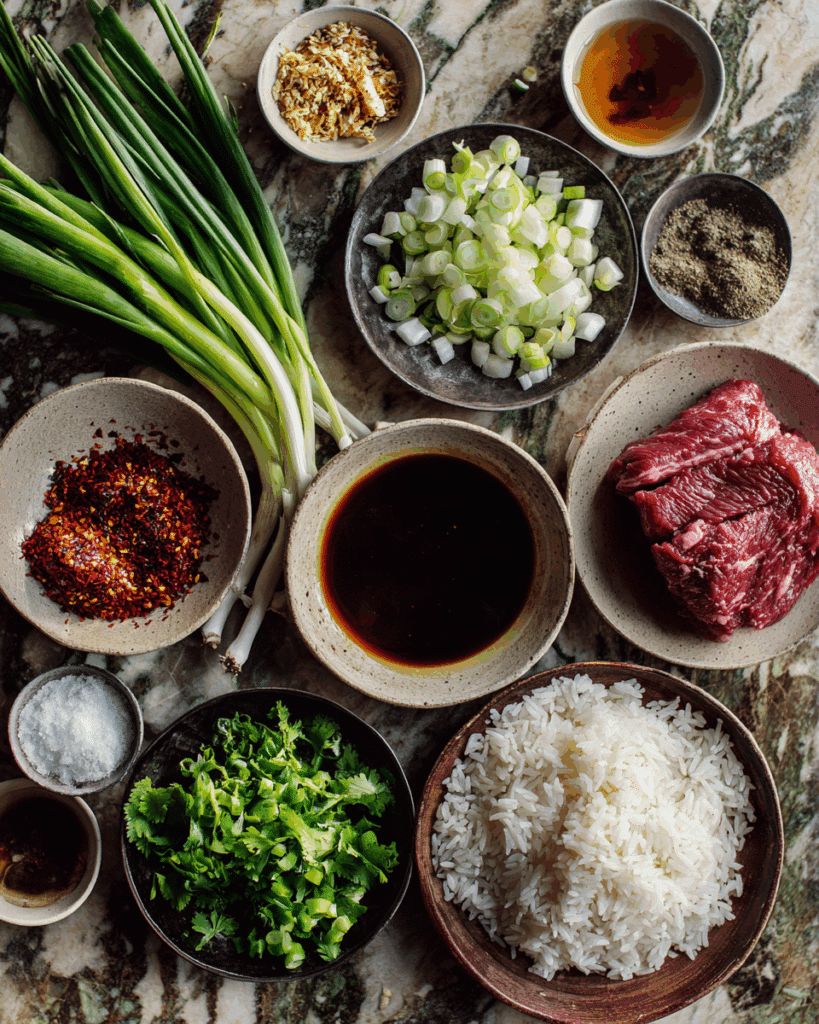
To create an authentic Nam Jim Jaew for Crying Tiger Beef, you’ll need:
- Tamarind sauce: the sour backbone that brightens the dish
- Fish sauce: umami-rich and deeply savory
- Palm sugar: softens the sharpness of sour and spice
- Chili flakes: for the essential heat
- Ground roasted rice: adds a nutty, smoky note and slightly thickens the sauce
- Fresh herbs: chopped shallot, spring onion, coriander, and optionally sawtooth coriander for extra aroma
The Preparation Process
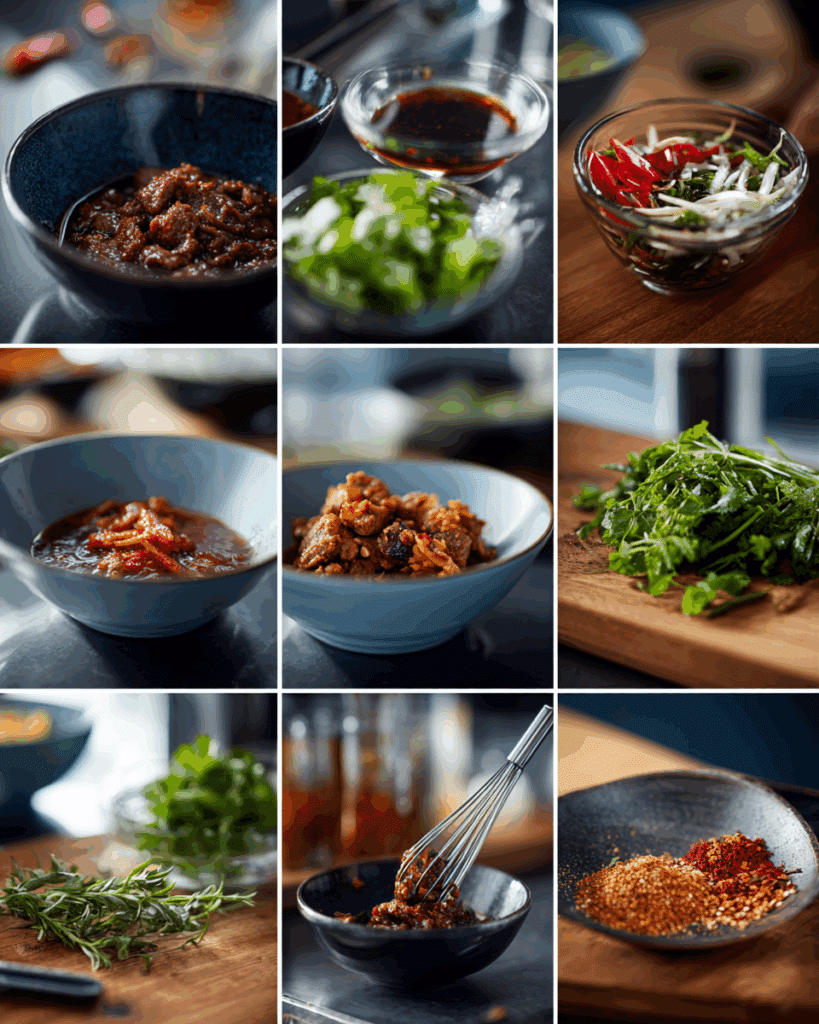
- Start by dissolving the palm sugar in tamarind and fish sauce until completely smooth.
- Stir in chili flakes and roasted rice powder.
- Fold in the fresh herbs just before serving so they retain their vibrant color and aroma.
- Taste and adjust — more tamarind for sourness, more sugar for sweetness, or more chili flakes for an extra fiery punch.
Why Roasted Rice is Essential
Ground roasted rice (khao khua) is a signature component in many Isan dishes, and in Nam Jim Jaew, it’s indispensable. The roasted rice adds a subtle crunch and a smoky aroma that ties the whole sauce together. You can make it at home by dry-toasting uncooked sticky rice until golden, then grinding it into a coarse powder.
Serving the Sauce
Nam Jim Jaew is served on the side, allowing diners to dip each piece of beef as they eat. Some people prefer spooning it directly over the meat, but the dipping ritual is part of the charm — you control exactly how much flavor you want in every bite.
Perfect Side Dishes and Pairings for Crying Tiger Beef
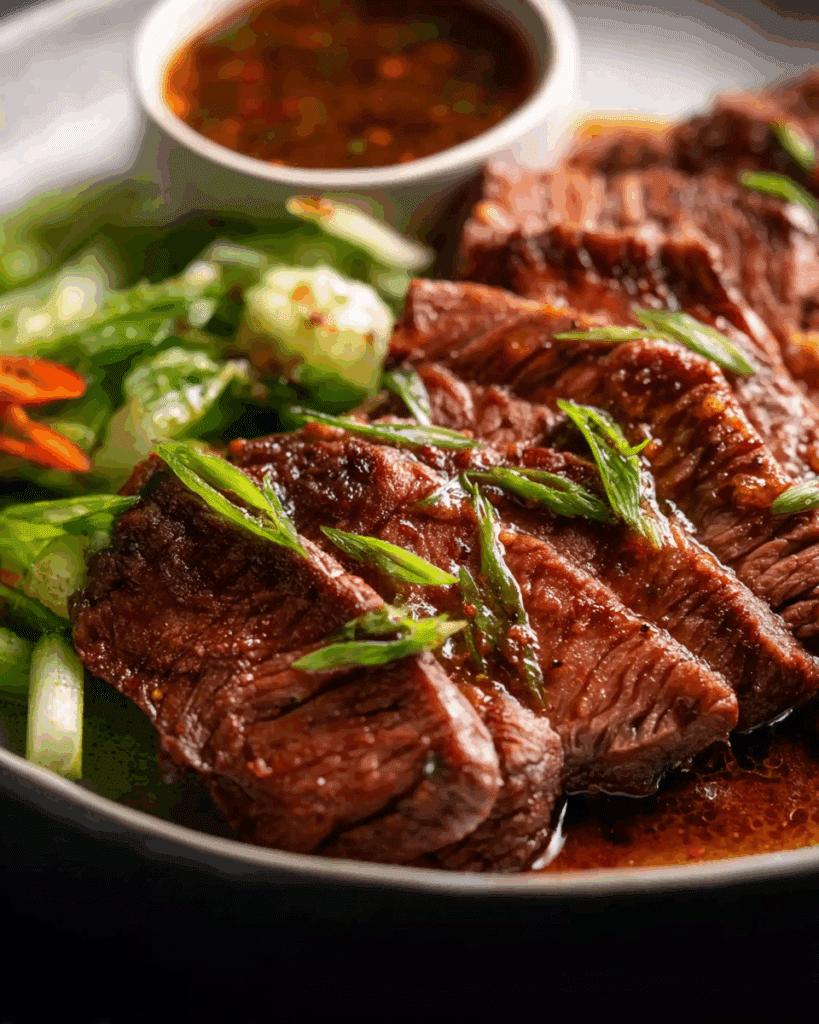
Traditional Thai Pairings
In its home region of Isan, Crying Tiger Beef is rarely eaten alone. The dish is typically paired with sticky rice, which acts as the perfect sponge for soaking up the flavorful dipping sauce. The chewy texture of sticky rice contrasts beautifully with the tender beef, making each mouthful more satisfying. Fresh vegetables like cucumber slices, lettuce leaves, and Thai basil are also served on the side to cool the palate after the spicy sauce.
Refreshing Salads
A crisp Thai green papaya salad (som tam) makes an ideal companion. Its tart, spicy, and slightly sweet flavors mirror the complexity of Crying Tiger Beef, creating a meal that dances between heat and freshness. For a lighter option, a crying tiger beef salad variation tosses thinly sliced beef with herbs, lime juice, and a lighter dressing, transforming the dish into a vibrant main course perfect for warmer weather.
Soups for Balance
Adding a mild soup alongside Crying Tiger Beef can balance the heat of the dipping sauce. Clear Thai soups with lemongrass and galangal, like tom yum with reduced chili, offer aromatic comfort without overpowering the beef. A coconut-based soup like tom kha gai brings creaminess that soothes the spice.
Fusion Pairings
While traditional accompaniments work wonderfully, modern kitchens have experimented with fusion sides. Think grilled vegetables drizzled with a light sesame dressing, or even roasted sweet potatoes for a subtle sweetness to balance the dish’s intensity. A fresh herb salad with mint, cilantro, and toasted peanuts can also add a crisp, nutty crunch.
Beverage Suggestions
Because Crying Tiger Beef leans heavily on bold flavors, beverages should either cleanse the palate or complement the heat. Thai iced tea or iced lemongrass tea offers a sweet counterpoint. Beer, especially light lagers, pairs exceptionally well, while crisp white wines like Riesling or Sauvignon Blanc can cut through the richness of the meat and sauce.
Modern Variations of Crying Tiger Beef
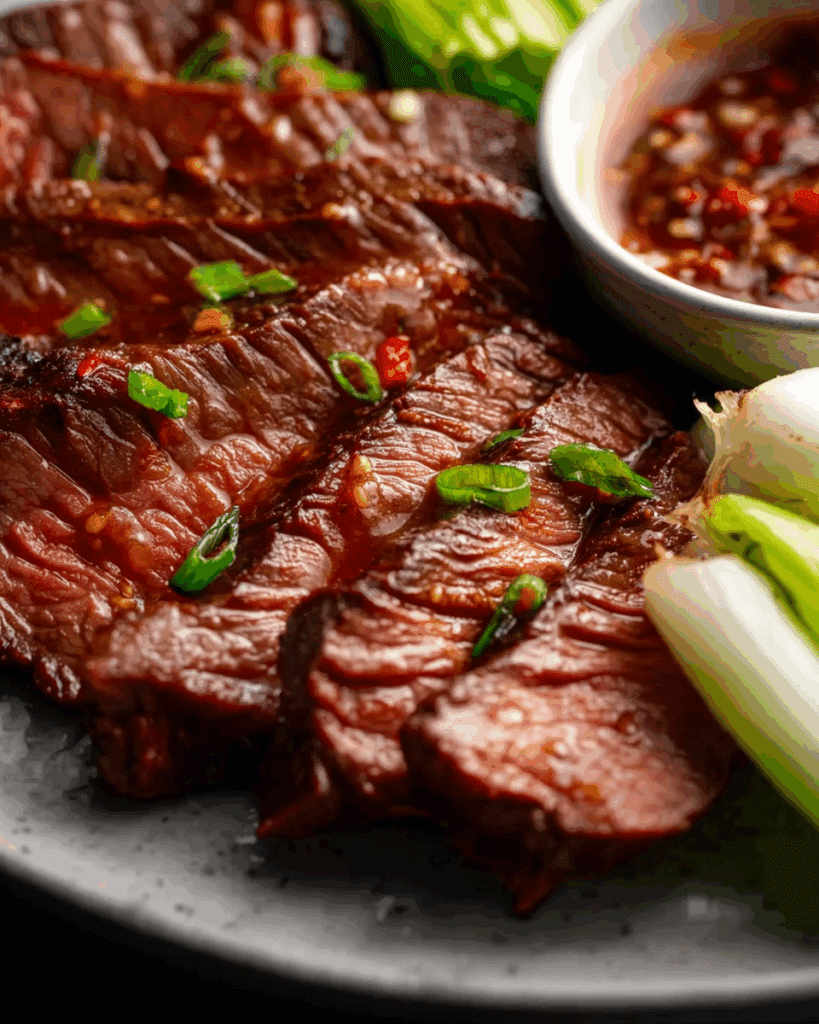
Crying Tiger Beef Salad
A popular twist is turning Crying Tiger Beef into a refreshing salad. In this version, thinly sliced grilled beef is tossed with fresh herbs like mint and cilantro, crisp vegetables such as cucumber and tomato, and a lighter variation of Nam Jim Jaew. The salad still delivers the same signature flavors but is less heavy, making it perfect for summer dining or as a vibrant appetizer.
Crying Tiger Chicken
For those who prefer poultry, Crying Tiger Chicken is a flavorful alternative. The marinade and dipping sauce remain largely the same, but chicken thighs or breast are used instead of beef. Grilling over charcoal works beautifully, giving the chicken the same smoky aroma that defines the beef version. This variation is also easier on the budget while still delivering bold flavors.
Crying Tiger Beef Recipe Easy
Home cooks short on time can simplify the process without sacrificing taste. Quick marinades using pre-mixed seasoning sauces and skipping the overnight marination can still yield excellent results. Pre-sliced beef cuts cook faster and make preparation more manageable for weeknight dinners.
Crying Tiger Marinade Experiments
Some adventurous cooks add unique ingredients to the marinade for a twist. Soy sauce can replace seasoning sauce for a slightly different umami profile, while fresh lime juice in the marinade infuses a tang right into the meat. A hint of garlic or even crushed black pepper can also add complexity.
Upscale Restaurant Style
Upscale interpretations often use premium cuts like wagyu or dry-aged beef, paired with an elegantly plated sauce drizzle instead of a dipping bowl. Garnishes might include microgreens, edible flowers, or thin slices of pickled vegetables. While more refined in presentation, these versions keep the essence of the dish intact — the tender meat, smoky char, and vibrant sauce.
Vegan or Plant-Based Adaptations
For those avoiding meat, marinated grilled mushrooms or thick slices of eggplant can stand in for beef. These vegetables absorb the marinade beautifully and work well with the dipping sauce. While not traditional, they offer a way to experience the spirit of Crying Tiger flavors in a plant-based form.
Common Mistakes to Avoid When Making Crying Tiger Beef
Overcooking the Beef
One of the easiest ways to ruin Crying Tiger Beef is by overcooking it. This dish shines when the beef is tender and juicy, typically cooked to medium-rare or medium. Overcooking leads to toughness, which can make each bite a workout rather than a pleasure. Always monitor cooking time closely and use a meat thermometer if needed to keep the temperature in check.
Skipping the Resting Step
After grilling, many people are tempted to slice the beef immediately. This is a mistake, as cutting too soon allows precious juices to escape, drying out the meat. Resting for at least 5–10 minutes lets the juices redistribute, ensuring every slice stays moist and flavorful.
Using Low-Quality Beef
Since this recipe has few ingredients, the quality of the beef plays a major role in the final outcome. Using cuts with poor marbling or meat that’s not fresh will result in a less satisfying dish. Choosing a good cut from a trusted source is essential for authentic flavor.
Overpowering the Marinade
While seasoning is important, too much marinade — especially one that’s overly salty or sweet — can mask the natural flavor of the beef. The goal is to enhance, not overpower. Balanced seasoning allows the beef’s natural richness to shine through.
Neglecting the Dipping Sauce
The Nam Jim Jaew dipping sauce isn’t optional; it’s a defining part of Crying Tiger Beef. Serving the dish without it or substituting with a generic sauce will strip away its authenticity. Taking the time to prepare it correctly is worth the effort.
Not Balancing the Sauce Flavors
Even if you make the dipping sauce, failing to balance the salty, sour, sweet, and spicy elements can lead to a flat taste. Always taste as you go, making small adjustments until the flavor sings.
Cutting the Beef the Wrong Way
Slicing with the grain instead of against it results in chewy strips of meat. Cutting against the grain shortens the muscle fibers, making each bite tender and easier to chew.
Health Benefits and Nutritional Insights of Crying Tiger Beef
Protein-Rich and Satisfying
Crying Tiger Beef is a protein powerhouse. A standard serving provides a substantial amount of high-quality protein, essential for muscle repair, growth, and maintaining a healthy metabolism. Protein also helps keep you feeling full for longer, making this dish a satisfying choice that can fit into balanced meal plans.
Rich in Essential Vitamins and Minerals
Beef offers key nutrients like iron, zinc, and vitamin B12. Iron supports healthy red blood cell production and oxygen transport throughout the body, while zinc is vital for immune system function and wound healing. Vitamin B12 contributes to nerve health and energy production, making this dish not only flavorful but also nourishing.
Healthy Fats in Moderation
When made with cuts like rump or flank, Crying Tiger Beef is relatively lean, yet still contains beneficial fats that contribute to satiety and flavor. Using marbled cuts like wagyu increases fat content, so portion control can help balance indulgence with health goals.
Nutritional Role of the Dipping Sauce
The Nam Jim Jaew sauce adds more than just taste. Tamarind brings antioxidants and digestive benefits, while fresh herbs like coriander and spring onion are packed with vitamins and phytonutrients. Chili flakes add capsaicin, which may help boost metabolism and support cardiovascular health.
Mindful Eating Considerations
Because fish sauce is naturally high in sodium, individuals watching their salt intake can adjust the recipe by reducing the amount or substituting with lower-sodium alternatives. Similarly, controlling the amount of palm sugar in the sauce can reduce overall sugar intake without compromising the dish’s balance.
A Balanced Thai Meal
When paired with sticky rice and fresh vegetables, Crying Tiger Beef becomes part of a complete Thai meal that offers a blend of protein, carbohydrates, fiber, and micronutrients. For an even lighter option, swapping sticky rice for fresh vegetable sides can lower calories while still delivering a satisfying, flavor-packed dining experience.
Conclusion
Crying Tiger Beef is more than just a meal; it’s a flavorful journey into the heart of Thai cuisine. From the smoky aroma of grilled beef to the tangy heat of the dipping sauce, every element tells a story of tradition, balance, and bold taste. Whether you follow the classic Isan recipe or explore modern variations like Crying Tiger Chicken or beef salad, the essence remains the same simple ingredients transformed into a dish that lingers in memory.
By choosing quality beef, respecting the balance of flavors, and paying attention to cooking techniques, you can recreate this Thai favorite in your own kitchen. Paired with sticky rice, fresh vegetables, or even creative fusion sides, Crying Tiger Beef stands out as a dish that brings people together over a shared love of great food.
FAQs About Crying Tiger Beef
Is crying tiger spicy to eat?
Yes, but the heat level can be adjusted. Traditional recipes use chili flakes generously, resulting in a noticeable kick. However, you can reduce the amount for a milder experience or increase it for extra heat, depending on your preference.
What’s in crying tiger sauce?
Crying tiger sauce, or Nam Jim Jaew, combines tamarind sauce, fish sauce, palm sugar, chili flakes, ground roasted rice, and fresh herbs like coriander and shallots. This mix creates a balance of sour, salty, sweet, and spicy flavors that perfectly complement the grilled beef.
Why is it called crying tiger beef?
The name has a few origin stories. One suggests the beef is so delicious that even a tiger would cry if it couldn’t have more. Another story says the “crying” refers to the juices dripping from the beef as it grills, resembling tears. Either way, the name adds intrigue to an already memorable dish.
What is crying tiger style beef?
Crying tiger style beef, or Suea Rong Hai, is a Thai dish featuring grilled beef served with a spicy, tangy dipping sauce called Nam Jim Jaew. The beef is typically marinated, grilled over charcoal, and sliced thinly for maximum tenderness. It’s a classic from Thailand’s northeastern Isan region, known for its bold and balanced flavors.

